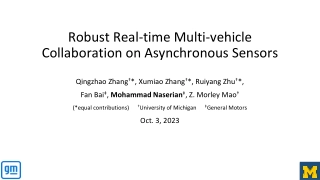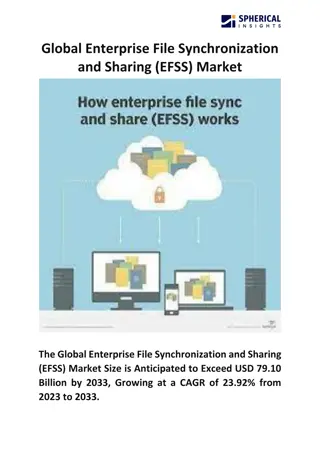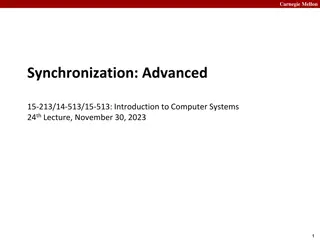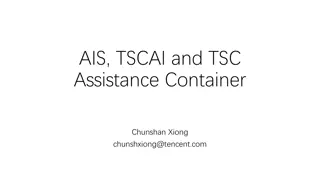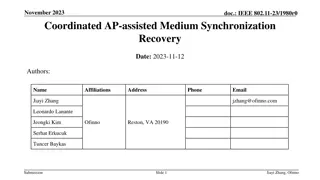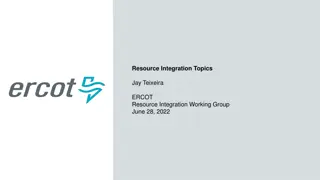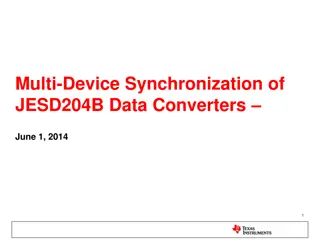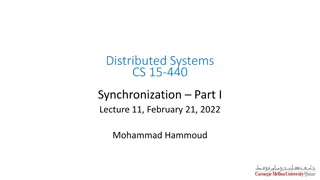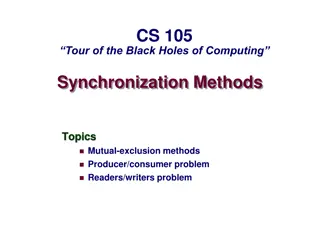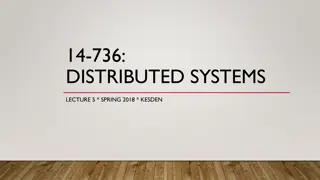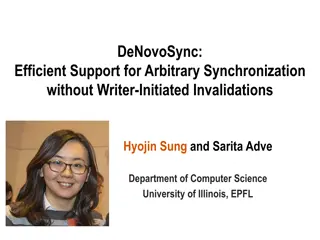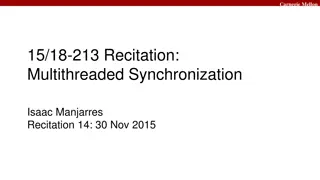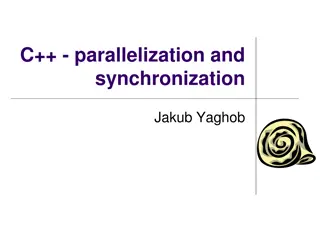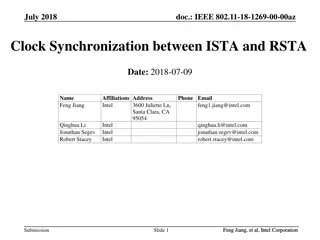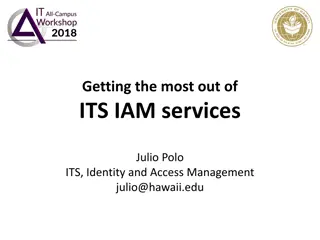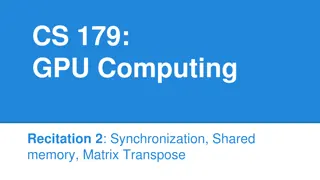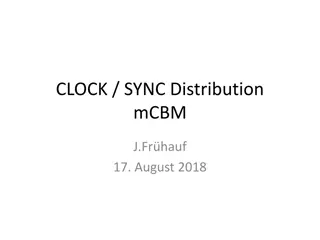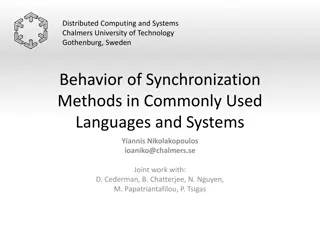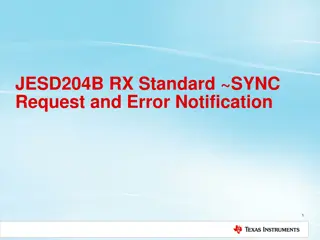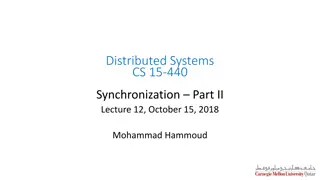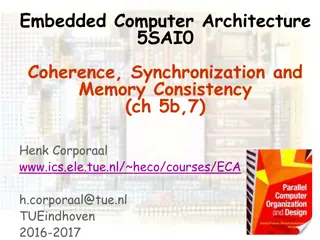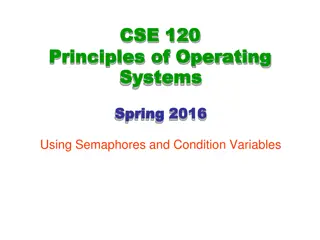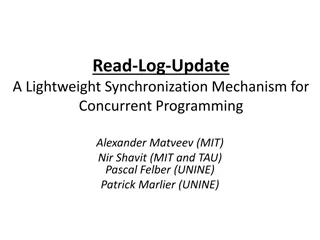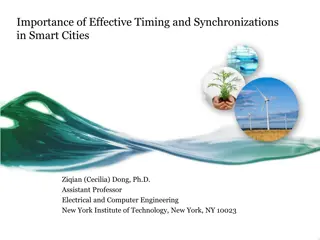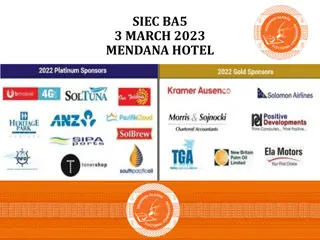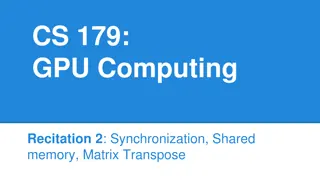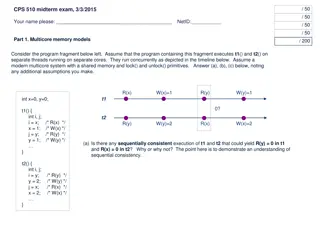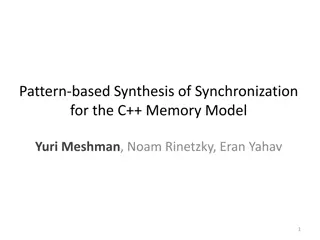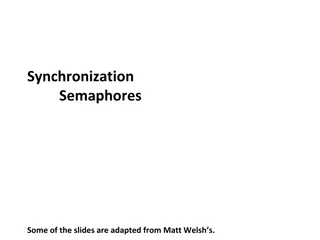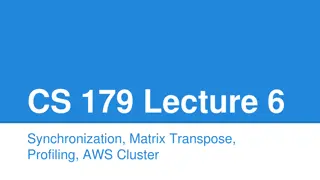Robust Real-time Multi-vehicle Collaboration on Asynchronous Sensors
A robust and real-time multi-vehicle collaboration system for asynchronous sensor data, addressing the synchronization problem and inaccurate blind spot estimation. The system leverages prediction algorithms for synchronization and enables on-demand data sharing for accurate blind spot estimation.
11 views • 12 slides
Mastering Synchronizing of AC Power Generating Equipment in Renewable Energy Training Course
This module focuses on educating learners about the synchronization process of AC power producing equipment, including the differences between synchronous and induction generators, calculating generator frequencies, and understanding the operation of synchroscopes and the three light bulb method for
1 views • 38 slides
Global Enterprise File Synchronization and Sharing
The Global Enterprise File Synchronization and Sharing (EFSS) Market Size is Anticipated to Exceed USD 79.10 Billion by 2033, Growing at a CAGR of 23.92% from 2023 to 2033.\n\n
0 views • 5 slides
Carnegie Mellon Synchronization and Computer Systems Lecture Updates
Carnegie Mellon's recent announcements include lab checkpoints and finals deadlines, as well as the release of an optional lab extension for the Shark File System. The lecture topics cover races, mutual exclusion, deadlock, semaphores, events, queues, reader-writer locks, starvation, and thread-safe
0 views • 43 slides
Time Synchronization in Cloud Gaming Services
Cloud gaming services like AIS, TSCAI, and TSC Assistance Container play a crucial role in providing quality of service (QoS) to millions of users globally. The need for time synchronization in 5G networks, especially for industrial applications like AR/VR, is highlighted. Trusted AF entities can di
0 views • 4 slides
IEEE 802.11-23/1980r1 Coordinated AP-assisted Medium Synchronization Recovery
This document from December 2023 discusses medium synchronization recovery leveraging multi-AP coordination for multi-link devices. It covers features such as Multi-link device (MLD), Multi-link operation (MLO), and Ultra High Reliability (UHR) capability defined in P802.11bn for improvements in rat
0 views • 8 slides
Coordinated AP-Assisted Medium Synchronization Recovery in IEEE 802.11-23/1980r0
This document discusses the proposal for medium synchronization recovery leveraging multi-AP coordination for multi-link devices in IEEE 802.11be EHT networks. It introduces the concept of AP-assisted medium synchronization recovery to assist non-AP STAs in transmitting frames without causing collis
0 views • 7 slides
Baltic Synchronization Plan and Frequency Stability Study
The Baltic Synchronization Plan explores the outcomes of the Frequency Stability Study, focusing on the effects on synchronous areas and the ENTSO-E procedure. It delves into scenarios involving existing and new HVDC links between countries like Poland and Lithuania, emphasizing the importance of th
0 views • 19 slides
Resource Integration Topics for Large Generation Projects: Planning and Synchronization
The resource integration topics discussed in the ERCOT Working Group cover Quarterly Stability Assessment (QSA) planning, synchronization dates, issues related to previous QSAs, and the process for large generation projects seeking simultaneous screening and full interconnection studies. Key deadlin
0 views • 15 slides
Multi-Device Synchronization in JESD204B Data Converters
Exploring the complexities of achieving multi-device synchronization with JESD204B high-speed data converters. This presentation discusses advantages, disadvantages, and key considerations such as deterministic latency and clock design. Learn about requirements, tools, and synchronization strategies
0 views • 45 slides
Synchronization in Distributed Systems: Examples and Taxonomy
Understanding the need for synchronization in distributed systems is vital for ensuring correct operation. Examples such as vehicle tracking and file writing highlight the importance of entities coordinating and agreeing on events and resource access. A broad taxonomy of synchronization reasons is d
2 views • 31 slides
Synchronization Methods in Computing
Exploring synchronization methods like mutual exclusion, deadlock, starvation, and hardware mutex support in computing. Learn about critical sections, preventing race conditions, and the challenges of synchronization. Consider the Test and Set method, its benefits and drawbacks, and the importance o
0 views • 24 slides
Challenges of Time Synchronization in Distributed Systems
Distributed systems face challenges in synchronizing physical time due to varying network paths and clock drifts. While physical time synchronization is useful for tasks like file timestamps, it involves complexities such as estimating communication latency and improving time estimation algorithms l
0 views • 30 slides
DL Synchronization and TCI State Activation Discussion
Discussing DL synchronization including TCI state activation with scenarios for beam indication timing, unified TCI framework, and reducing handover delay for Rel-18 LTM. Different procedures for DL synchronization and TCI state activation are explored, highlighting the importance of understanding a
0 views • 7 slides
Importance of Time in Computer Systems
Computer systems rely on accurate and stable timekeeping for various functions such as event scheduling, security certificates, and synchronization. Maintaining precise time is essential for ensuring proper system operations and data integrity. Challenges like temperature fluctuations and voltage ch
0 views • 22 slides
Efficient Support for Synchronization Without Invalidations
Addressing complex software issues like data races and inefficiencies in hardware synchronization, the DeNovoSync solution provides efficient support for arbitrary synchronization without writer-initiated invalidations. By introducing disciplined shared memory with structured synchronization and exp
0 views • 40 slides
Carnegie Mellon Multithreaded Synchronization Recitation
Explore Carnegie Mellon's recitation on multithreaded synchronization, debugging tools, shared memory synchronization, critical sections, and locking. Dive into the Echo Server Sequential Handling code examples, finding weaknesses using telnet, and advanced debugging techniques with curl and binary
0 views • 34 slides
Time, Clock Synchronization, and Atomic Clocks
Delve into the intricacies of time and clock synchronization, from the rotation of the Earth to atomic clock standards. Explore the importance of physical clock synchronization and the practical implications on technologies like GPS. Uncover the terminology and methodologies involved in achieving pr
0 views • 24 slides
Evolution of Upstream Burst Structure in 100G EPON Networks
Explore the advancements in upstream burst structure for 100G EPON networks discussed in IEEE 802.3 Working Group meetings. Key topics covered include burst loss probabilities, synchronization issues, SoB requirements, and the importance of burst delimiters. Updated analyses using MATLAB scripts and
0 views • 18 slides
C++ Parallelization and Synchronization Techniques
Explore the challenges of race conditions in parallel programming, learn how to handle shared states in separate threads, and discover advanced synchronization methods in C++. Delve into features from C++11 to C++20, including atomic operations, synchronization primitives, and coordination types. Un
0 views • 48 slides
IEEE 802.11-18-1269-00-00az Clock Synchronization Investigation
In July 2018, a document was presented by Feng Jiang et al. from Intel Corporation focusing on clock synchronization between ISTA and RSTA in IEEE 802.11-18-1269-00-00az standard. The document delves into the impact of sampling clock errors on range estimation, carrier frequency synchronization in 1
1 views • 10 slides
Enhancing Identity and Access Management Services at UHawaii
Explore the comprehensive integration of CAS and LDAP systems for efficient IAM services, including user management details, organizational affiliations, secure acknowledgements, and automatic data synchronization. Discover the UH Message Broker's role in maintaining critical data consistency and si
0 views • 18 slides
GPU Computing and Synchronization Techniques
Synchronization in GPU computing is crucial for managing shared resources and coordinating parallel tasks efficiently. Techniques such as __syncthreads() and atomic instructions help ensure data integrity and avoid race conditions in parallel algorithms. Examples requiring synchronization include Pa
0 views • 22 slides
Clock Synchronization Distribution For Data Taking Systems
The content details the clock synchronization distribution system for data taking systems requiring specific clock frequencies for various subsystems to ensure synchronous data processing. It covers the setup, external clock relationships, and generation specifics involving different clock frequenci
0 views • 10 slides
Performance Analysis of Synchronization Methods in Concurrent Data Structures
Explore the impact of synchronization methods on the performance and behavior of concurrent data structures in multithreaded applications. The study involves developing and implementing concurrent data structures, analyzing coarse-grain locking, fine-grain locking, lock-free mechanisms, and assessin
1 views • 25 slides
JESD204B RX Standard Synchronization and Error Handling
Explore the key functionalities of the JESD204B RX Standard, including synchronization requests, error detection, and reporting mechanisms. Learn about synchronization upon initialization, error handling requiring re-initialization, and more for reliable data link setup in JESD204B interfaces.
0 views • 11 slides
Distributed System Synchronization and Logical Clocks
Continuing from the previous lecture on time synchronization, this session delved into logical clock synchronization, mutual exclusion, and election algorithms in distributed systems. Logical clocks, such as Lamport's Clock and Vector Clock, play a crucial role in defining the order of events withou
0 views • 33 slides
Shared Memory Coherence, Synchronization, and Consistency in Embedded Computer Architecture
This content delves into the complexities of shared memory architecture in embedded computer systems, addressing key issues such as coherence, synchronization, and memory consistency. It explains how cache coherence ensures the most recent data is accessed by all processors, and discusses methods li
0 views • 47 slides
Principles of Operating Systems Synchronization Mechanisms
Operating systems utilize high-level synchronization mechanisms such as semaphores, condition variables, and monitors to provide synchronization beyond mutual exclusion. Semaphores are abstract data types that offer mutual exclusion to critical sections, while condition variables model uncounted eve
0 views • 21 slides
Lightweight Synchronization Mechanism for Concurrent Programming
This paper introduces a lightweight synchronization mechanism called Read-Log-Update (RLU), an extension to Read-Copy-Update (RCU). RLU simplifies programming with RCU by providing support for unsynchronized traversals and multi-location atomic updates within a single framework. It aims to preserve
0 views • 31 slides
Importance of Effective Timing and Synchronizations in Smart Cities
Effective timing and synchronizations play a crucial role in smart cities, facilitating communication between nodes in network systems. Time synchronization in wireless networks helps manage clock variations and energy consumption, aiding in tasks like location determination and proximity sensing. D
0 views • 18 slides
Electoral Reforms Presentation and Synchronization of Elections
Presentation outlining electoral reforms including synchronization of elections at all levels of governance to save costs and prevent duplication of services. Background details trials conducted in East Makira and West Kwaio Constituencies for simultaneous elections without major issues.
0 views • 26 slides
Synchronization and Shared Memory in GPU Computing
Synchronization and shared memory play vital roles in optimizing parallelism in GPU computing. __syncthreads() enables thread synchronization within blocks, while atomic instructions ensure serialized access to shared resources. Examples like Parallel BFS and summing numbers highlight the need for s
0 views • 21 slides
Locking and Synchronization in Multithreaded Environments
Exploring the concepts of locking and synchronization in the context of shared resources in multithreaded environments. Covering topics such as thread cooperation, coordination of access to shared variables, and the importance of synchronization mechanisms for controlling execution interleaving. Exa
0 views • 41 slides
Multicore Memory Models and CPU Protection in Operating Systems
This content covers topics related to multicore memory models, synchronization, CPU protection levels in Dune-enabled Linux systems, and concurrency control in multithreaded programs. The material includes scenarios, questions, and diagrams to test understanding of these concepts in the context of t
0 views • 10 slides
Pattern-Based Synthesis of Synchronization for C++ Memory Model
Examining the pattern-based synthesis of synchronization for the C++ memory model, this study delves into concepts like Dekker's Algorithm and achieving mutual exclusion in parallel programming. It discusses the automatic inference of efficient and correct synchronization under the C++ memory model,
0 views • 27 slides
Synchronization and Concurrency Best Practices
This content delves into essential concepts and best practices related to synchronization and concurrency in software development. It covers topics such as locks, condition variables, semantics, and semaphores, providing insights on how to ensure thread safety, manage shared data structures, and avo
0 views • 13 slides
Higher-Level Synchronization with Semaphores at Carnegie Mellon
Discover how Carnegie Mellon University explores higher-level synchronization primitives such as semaphores for effective thread management. Learn about the design and operations of semaphores, and compare them with traditional locking mechanisms. Dive into code examples and visual illustrations to
0 views • 40 slides
Achieving High Availability with DB2 HADR
Explore the concept of High Availability Disaster Recovery (HADR) in DB2, including its introduction in version 8.2, log-based replication, and its benefits for ensuring High Availability (HA) and Disaster Recovery (DR) at remote data centers. Learn about HADR's bundling with all DB2 versions (excep
0 views • 67 slides
Parallelism and Synchronization in CUDA Programming
In this lecture on CS.179, the focus is on parallelism, synchronization, matrix transpose, profiling, and using AWS clusters in CUDA programming. The content delves into ideal cases for parallelism, synchronization examples, atomic instructions, and warp-synchronous programming in GPU computing. It
0 views • 29 slides
